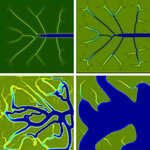Ecology & Zoology
We are used to hearing about the effects of climate change in terms of unusual animal behaviour, such as altering patterns of fish and bird migration. However, scientists at the University of Birmingham are trying out an alternative bio-indicator – the king penguin – to investigate whether they can be used to monitor the effects of climate change.
“If penguins are travelling further or diving deeper for food, that tells us something about the availability of particular fish in regions of the Antarctic. We may be able to assess the pressure exerted by king penguins on this ecosystem, and…

J. B. S. Haldane once famously quipped that "God is inordinately fond of beetles." Results of a study by Mark A. McPeek of Dartmouth College and Jonathan M. Brown of Grinnell College suggest that this fondness was expressed not by making so many, but rather by allowing them to persist for so long. In a study appearing in the April issue of the American Naturalist, McPeek and Brown show that many insect groups like beetles and butterflies have fantastic numbers of species because these groups are so old.
In contrast, less diverse groups, like mammals and birds, are evolutionarily younger.…

For all that Darwin did, Evolution as yet has no explanation for puzzling animal behavior.
Social insects provide some of the most fascinating examples of altruism in the natural world, with sterile workers sacrificing their own reproduction for the greater good of the colony.
That isn't the case with all insects - in some cases, there is a very real battle of the sexes going on, even in their larvae.
It's been generally believed that sterile 'soldier' larvae act in positive ways, by protecting them from attack by other species of parasitoids. Andy Gardner, Ian Hardy, Peter Taylor, and…

Intimidation and threats are common throughout society, whether it’s in the school playground, sporting arena or boardroom. Threatening behaviour is equally widespread among non-human animals.
Individuals signal their superior strength to competitors to obtain food, resolve territorial disputes and acquire mates. Current theory insists that signals of strength should be honest. Surprisingly researchers have found that dishonest signals are used routinely during dominance disputes by male Australian crayfish.
Crayfish are a naturally aggressive species and will squabble over almost anything…

Cultured fish cell lines and organs such as gills, heart, liver and intestines are being used to investigate the effects of toxins on fish such as freshwater trout and carp in a move to cut down the number of experiments carried out on live fish. Fish Biologists will be presenting new culture methods to help replace the use of live fish for safety testing of chemicals when they meet in Glasgow for the Annual Main Meeting of the Society for Experimental Biology on Sunday 1st April 2007. The move is in response to a European Commission directive to replace the use of animals in ecotoxicology…

Not from marijuana but from ... ethanol.
Many will be familiar with cravings for sweet food after having overindulged in alcohol the night before. Some may have cravings for salty foods after using marijuana - in Amsterdam, where it is legal, of course.
It appears that Egyptian fruit bats also crave particular types of sugar to reduce the effects of ethanol toxicity. Francisco Sanchez from the Ben-Gurion University of the Negev (Israel) will present data demonstrating this on Sunday 1st of April at the Society for Experimental Biology’s Annual Meeting in Glasgow.
Original photo ( not the…
Box jellyfish are much more active swimmers than other jellyfish – they exhibit strong directional swimming, are able to perform rapid 180 degree turns, and can deftly move in between objects. So how do they manage to manoeuvre the obstacle course that is in the sea bed? Given that they possess an impressive 24 eyes one would think they would be well equipped for this challenge! Dr Anders Garm (Lund University, Sweden) will present data demonstrating that it is one particular sub-set of eyes that performs this job, at the Society of Experimental Biology’s Annual Meeting in Glasgow (31st…

Fewer big sharks in the oceans led to the destruction of North Carolina’s bay scallop fishery and inhibits the recovery of depressed scallop, oyster and clam populations along the U.S. Atlantic Coast, according to an article in the March 30 issue of the journal Science.
A team of Canadian and American ecologists, led by world-renowned fisheries biologist Ransom Myers of Dalhousie University in Halifax, Nova Scotia, has found that overfishing in the Atlantic of the largest predatory sharks, such as the bull, great white, dusky and hammerhead sharks, has led to an explosion of their ray, skate…

A new, complete 'tree of life' tracing the history of all 4,500 mammals on Earth shows that they did not diversify as a result of the death of the dinosaurs, says new research published in Nature today.
The study was undertaken in the UK by scientists at Imperial College London and the Zoological Society of London (ZSL). It contradicts the previously accepted theory that the Mass Extinction Event (MEE) that wiped out the dinosaurs 65 million years ago prompted the rapid rise of the mammals we see on the earth today.
The multinational research team has been working for over a decade to…

Tidal marshes, which nurture marine life and reduce storm damage along many coastlines, should be able to adjust to rising sea levels and avoid being inundated and lost, if their vegetation isn't damaged and their supplies of upstream sediment aren't reduced, a new Duke University study suggests.
Such marshes "offer great value as buffers of coastal storms in cities such as New Orleans, which is separated from the Gulf of Mexico by marshlands," Matthew Kirwan and A. Brad Murray said in a report published online on Monday, March 26, in the journal "Proceedings of the National Academy of…